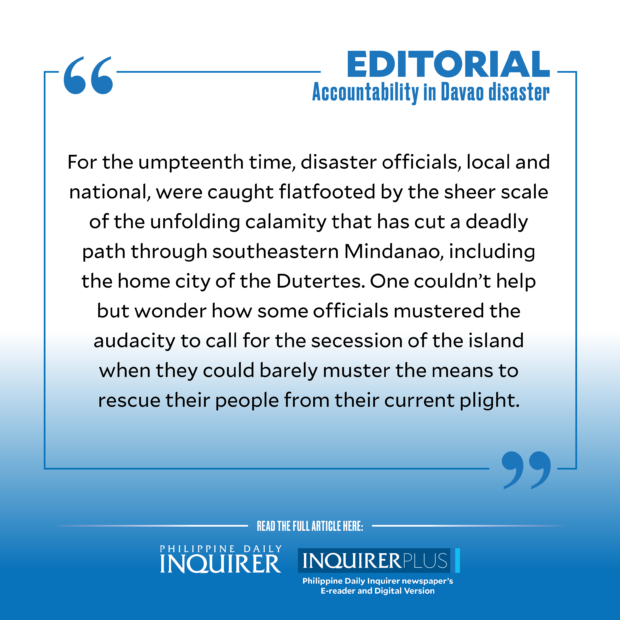Accountability in Davao disaster

The past weeks have seen parts of Davao region inundated by unceasing rains and landslides that killed dozens and displaced scores of others, leaving many still missing or presumed dead. Yet it seems our politicians, even those from the South, were too busy debating the merits of an independent Mindanao to care about their constituents drowning in floods or buried alive under mud, rocks, and debris.
In a way, the devastation across the region was the most compelling argument yet against such an absurd proposal, first put forth by former president Rodrigo Duterte during one of his public ramblings last month.
Notwithstanding the distraction posed by the divisive idea, one thing is clear: for the umpteenth time, disaster officials, local and national, were caught flatfooted by the sheer scale of the unfolding calamity that has cut a deadly path through southeastern Mindanao, including the home city of the Dutertes.
One couldn’t help but wonder how some officials mustered the audacity to call for the secession of the island when they could barely muster the means to rescue their people from their current plight, a predictable fate for any disaster-ravaged community in this country.
Building resiliency
For all the rhetoric about the “new normal” and the familiar refrain about building resiliency, the government’s disaster management program appears to be stuck in its old ways, when having multiple casualties is the expected outcome of any natural or human-caused catastrophe, rather than an exception.
On Feb. 5, the Office of Civil Defense (OCD) attributed the death and destruction in Davao to “continuous rains in the upland areas, the heavy siltation of Tagum-Libuganon River, and the rise of water levels in several river systems due to excessive rains.”
The office, the implementing arm of the National Disaster Risk Reduction and Management Council (NDRRMC), raised the urgency of finding long-term solutions to widespread flooding even in areas not historically known to experience them.
“We cannot deny the fact that there are challenges and existing problems that need to be resolved with regard to the recurring problem of flooding in various areas of the country and these are pressing concerns,” OCD administrator Ariel Nepomuceno said.
‘Clearer accountabilities’
Among the solutions he identified were “strict [law enforcement] against human activities that aggravate the problems such as irresponsible mining practices,” “improvement of flood-control projects and other engineering interventions,” and “permanent relocation of vulnerable communities.”
“Clearer accountabilities must also be drawn,” he added.
The last line hit the nail on the head.
Alas, Nepomuceno did not elaborate on the kind of official answerability that must be exacted in situations like this, when instead of taking our leaders to account for their shortsightedness and lack of planning, the blame is passed on instead to extreme weather volatility and the lack of infrastructure, manpower, and technology to address climate change—the same old excuses in the old normal.
All these underscore the failings of the national government and local government units (LGUs) in their mandate under the Philippine Disaster Risk Reduction and Management Act of 2010 to “recognize the local risk patterns across the country and strengthen the capacity of LGUs for disaster risk reduction and management through decentralized powers, responsibilities, and resources at the regional and local levels.”
Full reckoning
Under Republic Act No. 10121, NDRRMC is tasked with establishing “a national early warning and emergency alert system to provide accurate and timely advice to national or local emergency response organizations and to the general public.”
While alerts were issued from NDRRMC to its regional and provincial chapters, we have to ask: Were these disseminated in time and residents given ample warning to flee to safety?
In the case of a mining community in Maco town, Davao de Oro, there had been no warning at all. A rain-induced landslide had engulfed two buses of Apex Mining Co. and several houses in the mountainous area last week, trapping workers and leaving many dead or missing.
“There was no sign that a landslide would occur because the rains stopped on Thursday and by Friday it was already sunny and hot,” provincial disaster official Edward Macapili told Agence France-Presse.
But was it truly just an accident that could not have been prevented with adequate warning, preparation, and preemptive evacuation?
As the death toll in Davao mounts, there must be a full reckoning of which officials are responsible for this tragedy, what they could have done better, or differently, to avoid it, and, most importantly, what must be done to prevent a repeat.
Climate change is triggering more and more unpredictable weather events, but a foolproof disaster management plan can shield our people from the impact, allowing our country to weather calamities with the least damage and human toll possible.




















